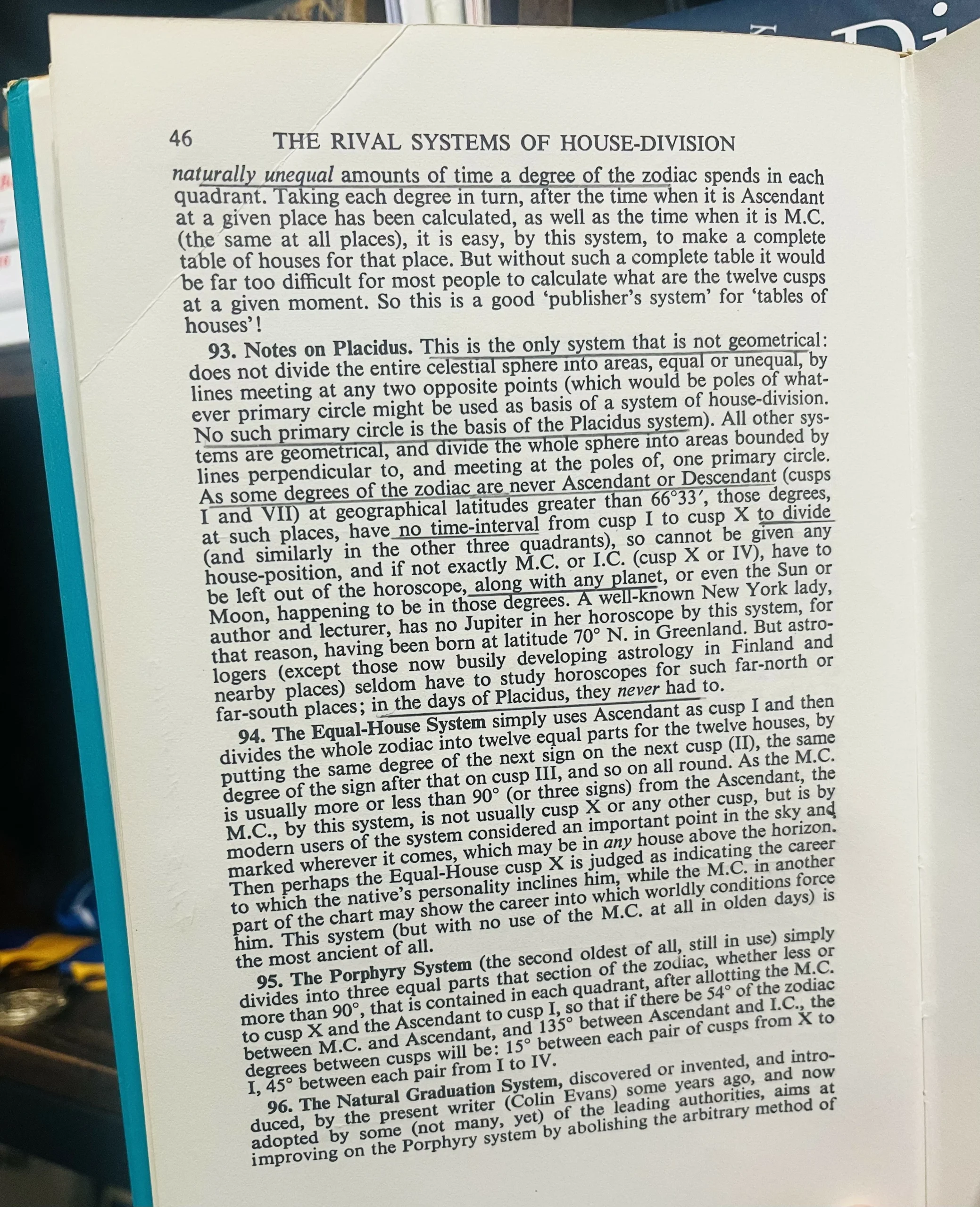Learn the reason for which it is said that certain Zodiacal degrees never rise within the polar regions.
The following is one of many instances where professionals present a view on a phenomenon they believed to have understood completely or whose reality they found interpretively unsettling or disturbing. In this sense, sometimes professionals who are exceptionally competent and whose works we recommend herein make assertions that the vast majority of readers (students and professionals alike) take for granted or accept without question, that is, they read it foregoing an independent exercise in order to have these assertions confirmed or otherwise disproven. While it is true that many of us prefer others to think for us, it is necessary to produce autonomous critical reflections. Astrology is not magic. It is a scientific discipline like any other (as natural and inexact as meteorology and medicine and as exact as mathematics and formal logic with regard to horoscope construction).
When authors or astrologers say that, in the polar regions, certain signs of the Zodiac or certain degrees “never rise,” this must not be taken to mean that there are instances of time where there is no ASC (no, no one is born without an ASC and MC). What is meant, rather, is that particular degrees may rise by retrograde motion or never become a conventional ASC because (a) the ecliptic is ascending strictly parallel relative to the plane of the local polar horizon, (b) the latitude is so extreme (beyond 80º N) that the summer signs never cross downwards nor the winter signs upwards, or (c) the polar meridian is usurping, from an astrographical standpoint, the function of the ‘sunrise’ or ‘dawn’ from the eastern horizon. It is not that the corresponding signs or degrees (Pisces, Aries, Taurus) are failing to rise above the eastern horizon. They do rise, but they do so strictly parallel to the plane of the polar horizon in both instance ‘(c)’ and during the retrograde ascent of the ASC. During instance ‘(c)’, for example, the signs of Pisces, Aries, and Taurus will appear ascending through the East point while, at the northern point of the polar horizon, the signs or degrees of Gemini, Cancer, and Leo are concurrently “dawning,” (midnight Sun) for every degree of every sign retains the behaviour of the Sun when it occupied that degree or sign at that latitude. [1]
This is what makes Waite’s (1917), Evans’s (1953) and/or Gardener’s (1971) words in The New Waite’s Compendium of Natal Astrology (published by Samuel Weiser Inc. in New York in 1971, p. 45, par. 93) a misinterpretation of a completely normal, or at least natural, phenomenon:
“As some degrees of the Zodiac are never Ascendant or Descendant […] those degrees […] have no [considerable or otherwise noticeable] time-interval from cusp 1 to cusp 10 to divide […] so cannot be given any house-position [that is, houses tenth and eleventh become significantly ephemeral] and if not exactly on the MC or IC [because, again, the local meridian has usurped the astrological functions of an eastern/western horizon], have to be left out of the horoscope, along with any planet, or even the Sun or Moon, happening to be in those degrees.” [2]
We are, therefore, presented with either an ill learnt concept or an equivocal interpretation. Whatever planet occupies a degree that cannot ever become or constitute an ASC shall always appear lodged within the twelfth house (and vice versa, in the sixth house, concerning the opposite degree). Inasmuch the author(s) aforementioned did not understand this (in their epochs it could have proven to be somewhat difficult without technological simulations that would have allowed to appreciate it visually), some went as far as to say that a native born at 70º N (Greenland) “has no Jupiter in her horoscope by this system [of houses]” (idem).
What is even more grave or concerning is for an astrologer to assert that a person lacks a certain planet in their birth chart under one system of houses but possesses it under another, without showing concern for the theoretical, logical, or astronomical integrity of the discipline. The same patient cannot, simultaneously, show a bone according to one X-ray and not show the same bone according to another X-ray. Such a discrepancy would greatly undermine the credibility of the medical field, as, in this case, it undermines ours.
As Michael Edwards once said, ‘It is time to put our house in order, and our houses.’
______________________________
[1] At even more extreme latitudes, i.e. beyond 75 N, the summer signs and winter signs remain perpetually above and below the horizon, respectively. That is, the summer signs never descend, while the winter signs never ascend.
[2] Other assertions within this work, such as the claim that the Placidus method of house division does not rely upon or dispenses with great circles or that it is the only non-geometric method—for it remains strictly upon the ecliptic and does not appeal to external geometric constructs such as the prime vertical of Campano de Novara or the celestial equator of Regiomontano—are entirely correct. On the page preceding the one photographed herein, however, appears a particularly egregious error with regard to the description of the mechanism of action of the Placidian method of house division, which we will address in a future publication.









